PSYC 170 - Summer 2013 - Professor Claffey
Notes: Organization
pdf
Version:
8/4/13 - adapted from Hans Peterson's notes
10/30/12 - original version
Anatomical Directions in Humans
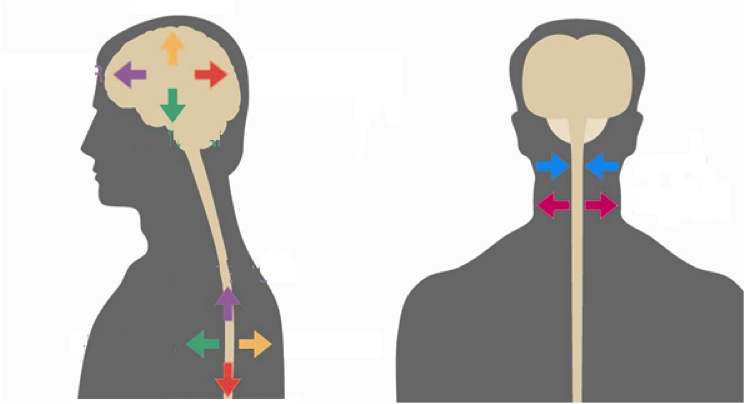
Planes of the Brain
Anatomy of the Nervous System
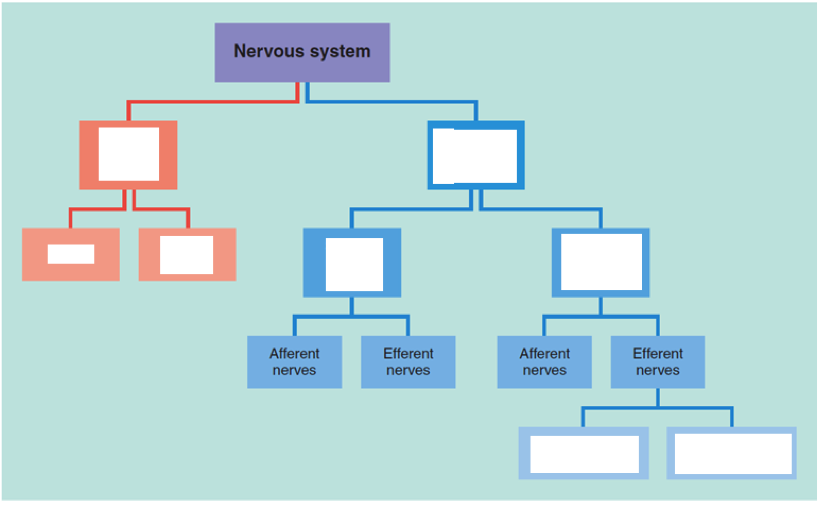
Responsibilities:
- ___________ and _____________ information from the body
- _________________ the activity of the body
Peripheral Nervous System
____________ neurons - carry sensory signals from the body that arrive in the brain
____________ neurons - carry motor signals to the body that exit the brain
Somatic System
_______________ control of body movements
Autonomic System
controls visceral functions, largely outside of _________________________
Sympathetic
Engages the bodys __________________, increase/decrease energy expenditures
Heart Rate: Digestion:
Respiratory Rate:
Perspiration:
Parasympathetic
Engage the body's _____________________, increase/decrease energy expenditures
Central Nervous System
Consists of the _________ and __________________________
Spinal Cord
Primary functions:
- Conduct ________________ information from the brain to the muscles
- Conduct ________________ information from the body to the brain
- Contain circuits for __________________ and pattern generation
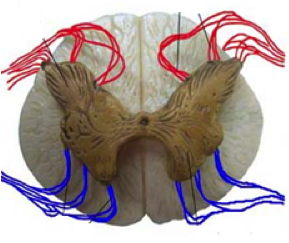
|
___________________ makes up the outside of the spinal cord, consisting
of highly myelinated axons that carry information either up or down the
spinal cord
___________________ the inner component of the spinal cord, primarily
composed of cell bodies and ___________________, which allow motor and
sensory neurons to communicate
__________ side - afferent/efferent (sensory neurons)
__________ side - afferent/efferent (motor neurons) |
Protecting the Brain
The ____________ provides protection against impact and force.
Underneath the skull is the ________________, which act like a wrapper.
________________________ provides cushioning and is involved in
the healthy exchange of molecules.
produced in the
_____________________, which are several large hollow cavities
throughout the brain.
Chemical Protection
The brain is protected by foreign chemicals by the ___________________________, a
tightly-packed system of cells wrapped around blood vessels walls that
prevent many molecules from entering the brain.
Advantages Protects from foreign bodies, and thus brain infection is quite rare
Disadvantages Because the blood brain barrier prevents many molecules
from reaching the brain, it is difficult to develop pharmaceuticals that
can act upon the brain.
Brain Subdivisions
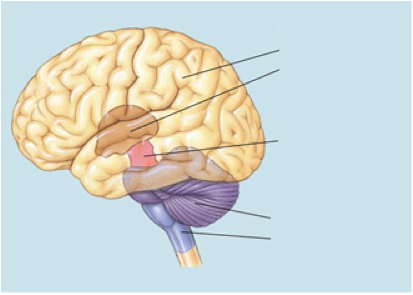
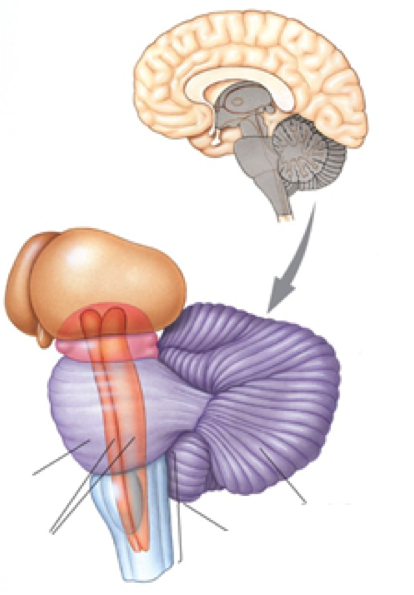
|
Myel-encephalon
____________ Involved in various autonomic processes in the body, including respiratory and cardiac functioning.
___________________ Involved in sleep-wake cycle and habituation.
Met-encephalon
______________ Also autonomic functioning such as regulating breathing
__________________ motor behavior, balance, movement and coordination
|
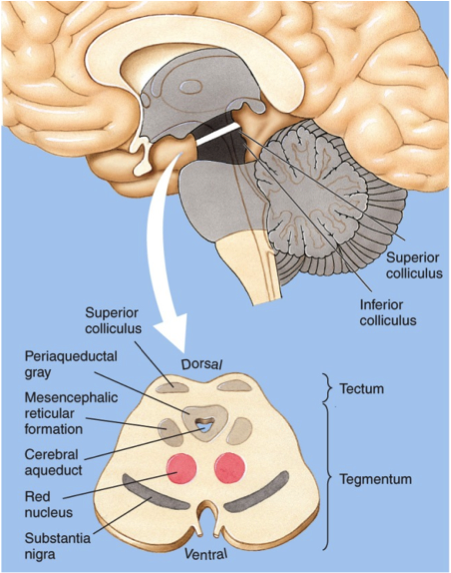
|
Mes-encephalon
Mid brain
- preliminary vision & auditory processing
- rich in dopaminergic neurons - movement and reward
-
motor coordination and communicating with the cerebellum and motor cortex
-
processing pain
|
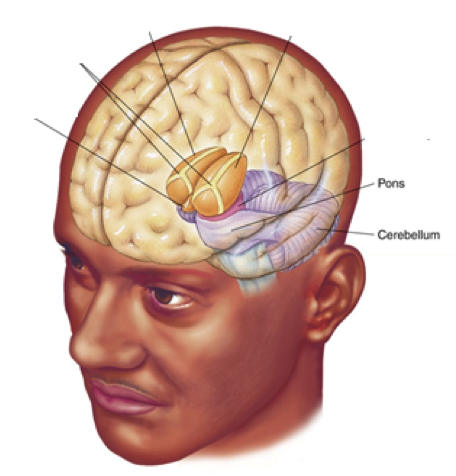
|
Di-encephalon
________________
-
regulatory
gateway
- all sensory input goes through the thalamus
- visual input in Lateral Geniculate Nucleus (LGN)
- auditory input in Medial Geniculate Nucleus (MGN)
__________________
- links the
nervous system to the endocrine system via the pituitary gland
- regulates body temp, hunger, thirst, and other autonomic process
|
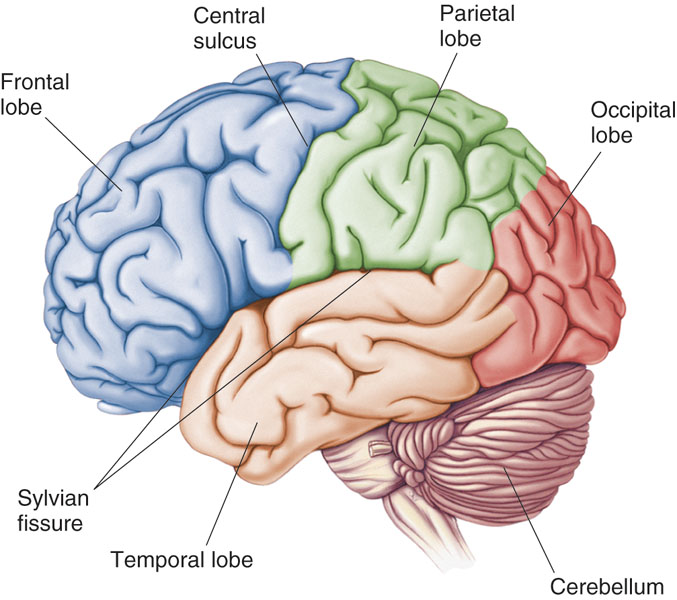
|
Tel-encephalon
-
Evolutionarily the most recent part of the brain
-
Our complex behavior such as voluntary movement, sensory input,
speaking, memory, problem solving, and other executive functions are
developed here. There are two parts that comprise the telencephalon, the
______________ and _______________.
|
______________ groove in cerebral cortex
______________ ridge or wrinkle in cerebral cortex
______________ deep groove in cerebral cortex
______________________ divides right and left hemisphere
______________________ divides frontal lobe and parietal lobe
______________________ divides frontal lobe and parietal lobe from temporal lobe
______________________ intercortical structure that allows right and left hemisphere to communicate with one another
Cerebral cortex
Cortical layers
 |
2-4 mm thick with white
matter underneath
cortex has layers that differ in neuron organization
some layers consist mostly of:
_________________ from _____________neurons__
signals
arriving from other areas of the brain (__________)
____________________
densely packed
neurons with many synapses (_____________)
__________________ of neurons whose
axons
project to other cortical areas (__________________)
|
__________________ cells
one of the main types of neurons in the cortex
large multipolar (many extensions) neurons
many dendrites extending up towards surface of
cortex
large axon that extends down and then to other
areas of the cortex
these axons are what make up
the white matter
integrates signals and communicates to other
areas of the brain
Occipital Lobe
dedicated to processing ________________ input
information proceeds from _____________ to ______________ processing
cells sensitive to edges, color, shapes, orientation
specialized areas for ______________ and ________________________
Ventral vs dorsal stream
information flowing along dorsal stream processes _________ objects are
information flowing along ventral stream processes _________ objects are
Parietal Lobe
_____________________ cortex - receives sensory input from body
_____________________ cortex
integrating vision (dorsal stream) / hearing / touch
attention
sense of space and our bodies relation to space
Temporal Lobe
superior temporal gyrus (top) - __________________ and __________________
inferior temporal gyrus (bottom) - "what" or ventral stream of
__________________
medial temporal lobe (inside) - hippocampus, declarative
__________________
Frontal Lobe
primary motor cortex (__________________ movement control)
secondary motor areas (__________________ movement control)
prefrontal cortex - advanced __________________ functions, __________________
"pre" meaning before or in front of
Subcortical Structures
"subcortical" is
everything under the cortex (the very outer surface)
includes areas introduced above: thalamus, hypothalamus, medulla, pons, cerebellum
includes the limbic system & basal ganglia
Limbic system
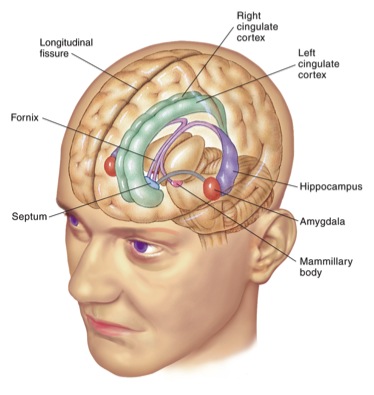 |
circles the thalamus
(limbic is Greek for ring)
regulates the four Fs of behavior:
fighting, fleeing, feeding, and ______________
Areas
________________
declarative memory
knowledge that can
be declared as oppose to procedural memory
________________
(Greek: almond)
emotional learning, fear &
aggressive behaviors
|
Basal ganglia
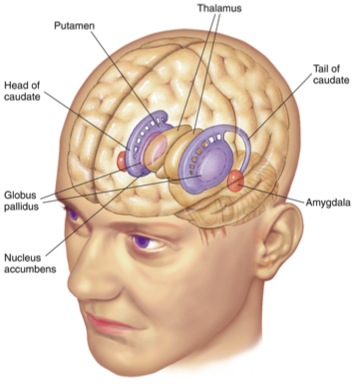
|
Serves as the _______________ for selecting movement
It is as though the cortex is "proposing" many
different actions and the basal ganglia selects
only one
May also select ______________ and ________________ decisions
Consists of:
- caudate (dorsal striatum)
- putamen (ventral striatum)
- globus pallidus
- subthalamic nuclei
|
Copyright 2013 - Michael Claffey













